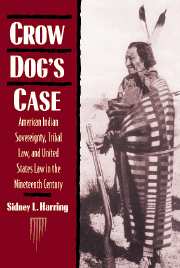 Crow Dog's Case
Crow Dog's Case Book contents
- Frontmatter
- Contents
- Acknowledgments
- 1 “This high pretension of savage sovereignty”
- 2 Corn Tassel: state and federal conflict over tribal sovereignty
- 3 U.S. Indian law and the Indian nations: the Creek Nation, 1870–1900
- 4 Crow Dog's case
- 5 Imposed law and forced assimilation: the legal impact of the Major Crimes Act and the Kagama decision
- 6 Sitting Bull and Clapox: the application of BIA law to Indians outside of the Major Crimes Act
- 7 The struggle for tribal sovereignty in Alaska, 1867–1900
- 8 The legal structuring of violence: U.S. law and the Indian wars
- 9 Conclusion
- Index
2 - Corn Tassel: state and federal conflict over tribal sovereignty
Published online by Cambridge University Press: 23 September 2009
- Frontmatter
- Contents
- Acknowledgments
- 1 “This high pretension of savage sovereignty”
- 2 Corn Tassel: state and federal conflict over tribal sovereignty
- 3 U.S. Indian law and the Indian nations: the Creek Nation, 1870–1900
- 4 Crow Dog's case
- 5 Imposed law and forced assimilation: the legal impact of the Major Crimes Act and the Kagama decision
- 6 Sitting Bull and Clapox: the application of BIA law to Indians outside of the Major Crimes Act
- 7 The struggle for tribal sovereignty in Alaska, 1867–1900
- 8 The legal structuring of violence: U.S. law and the Indian wars
- 9 Conclusion
- Index
Summary
The foundational case in federal Indian law is Worcester v. Georgia (1832). Known collectively with Cherokee Nation v. Georgia (1831) as one of the “Cherokee cases,” it has been the subject of much analysis, particularly for its formulation of tribal sovereignty. The case precipitated a famous constitutional crisis when President Andrew Jackson remarked, “John Marshall has made his decision, now let him enforce it,” and refused to use federal power to protect Cherokee rights against Georgians. This conflict itself illustrates the core contradiction in Indian law cases during most of the nineteenth century: federal Indian law evolved in a legal battle with the states over federal control of Indians and Indian lands, with tribal sovereignty or the legal rights of native people often not even of secondary concern. Hence, Chief Justice John Marshall's famous pronouncements of Indian rights were virtually meaningless to the tribes.
All modern legal discussions of the Cherokee cases omit consideration of the first such case, Corn Tassel, which, although known to legal scholars because it establishes the context for the more famous cases, is never seen as having doctrinal meaning. In addition to demonstrating the wholesale federal abandonment of treaty obligations toward the Cherokee, the case represents a cowardly cession of both federal power and tribal sovereignty to the states. This action dominates early-to mid-nineteenth-century Indian law.
Corn Tassel's case
All of the Cherokee cases arose from the same tragic violation of tribal rights.
- Type
- Chapter
- Information
- Crow Dog's CaseAmerican Indian Sovereignty, Tribal Law, and United States Law in the Nineteenth Century, pp. 25 - 56Publisher: Cambridge University PressPrint publication year: 1994


